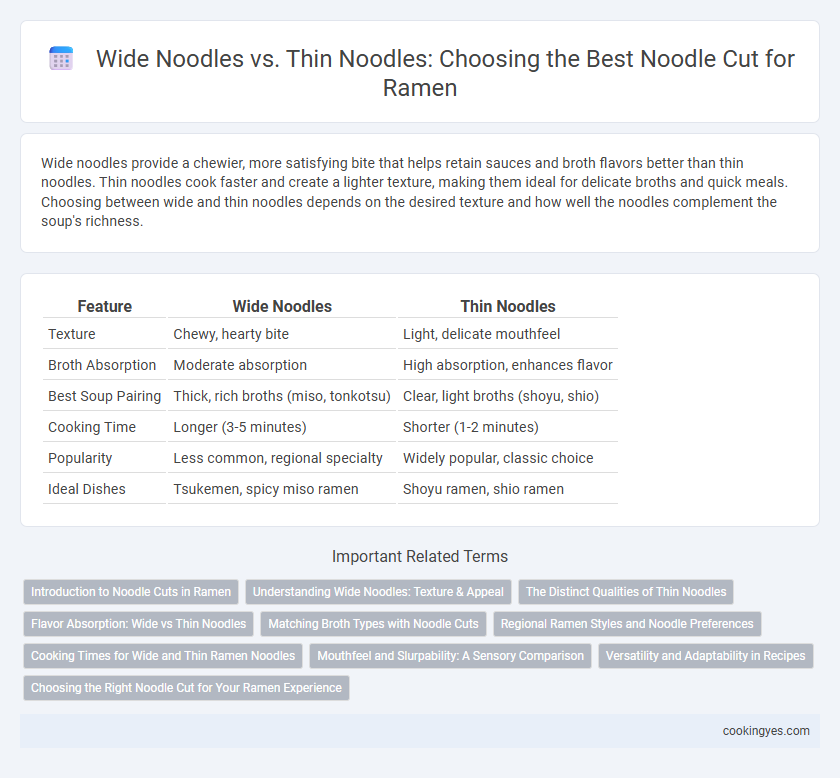Wide noodles provide a chewier, more satisfying bite that helps retain sauces and broth flavors better than thin noodles. Thin noodles cook faster and create a lighter texture, making them ideal for delicate broths and quick meals. Choosing between wide and thin noodles depends on the desired texture and how well the noodles complement the soup's richness.
Table of Comparison
| Feature | Wide Noodles | Thin Noodles |
|---|---|---|
| Texture | Chewy, hearty bite | Light, delicate mouthfeel |
| Broth Absorption | Moderate absorption | High absorption, enhances flavor |
| Best Soup Pairing | Thick, rich broths (miso, tonkotsu) | Clear, light broths (shoyu, shio) |
| Cooking Time | Longer (3-5 minutes) | Shorter (1-2 minutes) |
| Popularity | Less common, regional specialty | Widely popular, classic choice |
| Ideal Dishes | Tsukemen, spicy miso ramen | Shoyu ramen, shio ramen |
Introduction to Noodle Cuts in Ramen
Wide noodles in ramen offer a chewy texture and a robust bite that holds rich, thick broths well, enhancing hearty styles like miso or tonkotsu ramen. Thin noodles provide a delicate, springy mouthfeel that quickly absorbs lighter, clearer soups such as shoyu or shio ramen, allowing the broth's subtle flavors to shine. Choosing between wide and thin cuts depends on the desired balance between noodle texture and broth intensity in traditional ramen preparations.
Understanding Wide Noodles: Texture & Appeal
Wide ramen noodles offer a chewier texture that enhances the overall eating experience by absorbing more broth flavor, making each bite rich and satisfying. Their broad surface allows for better clinging of thick, hearty sauces and toppings, complementing robust ramen styles like miso or tonkotsu. Compared to thin noodles, wide noodles deliver a substantial mouthfeel and balanced chewiness that appeal to those seeking depth and texture in their bowl.
The Distinct Qualities of Thin Noodles
Thin noodles in ramen offer a delicate texture that absorbs broth flavors more efficiently, enhancing the overall taste experience. Their slender shape allows for quicker cooking times, preserving a pleasant firmness and preventing mushiness. Often preferred in lighter ramen styles like shio or shoyu, thin noodles provide a smooth, silky bite that complements subtle, clean broths.
Flavor Absorption: Wide vs Thin Noodles
Wide noodles have a larger surface area that allows them to absorb more broth, delivering richer and more intense flavors in each bite. Thin noodles, while quicker to cook and lighter in texture, absorb broth more subtly, preserving the delicate balance of flavor without overpowering the dish. The choice between wide and thin noodles significantly influences the overall flavor experience of ramen, with wide noodles enhancing broth absorption and thin noodles maintaining a lighter taste.
Matching Broth Types with Noodle Cuts
Wide ramen noodles excel in absorbing rich, thick broths such as miso or tonkotsu, providing a balanced and hearty mouthfeel. Thin noodles pair best with lighter, clearer broths like shoyu or shio, allowing delicate flavors to shine without overwhelming the palate. Selecting the appropriate noodle width enhances the overall texture and flavor harmony in each ramen bowl.
Regional Ramen Styles and Noodle Preferences
Regional ramen styles in Japan distinctly influence noodle preferences, with wide noodles commonly favored in Sapporo-style miso ramen for their ability to hold rich, hearty broths. Thin noodles are preferred in Hakata ramen to complement the light, creamy tonkotsu broth, allowing for a quicker, firmer bite. These variations in noodle cut enhance the overall texture and flavor balance unique to each ramen region's culinary tradition.
Cooking Times for Wide and Thin Ramen Noodles
Wide ramen noodles typically require a longer cooking time of 3 to 5 minutes due to their thickness and surface area, allowing them to absorb more broth flavor. Thin ramen noodles cook much faster, usually within 1 to 2 minutes, resulting in a firmer texture that holds up well in lighter soups. Adjusting cooking times based on noodle width ensures optimal texture and taste in ramen dishes.
Mouthfeel and Slurpability: A Sensory Comparison
Wide noodles in ramen offer a chewy, substantial mouthfeel that enhances the eating experience by providing a satisfying bite, while thin noodles create a lighter, silkier texture that amplifies slurpability and allows the broth to coat each strand more evenly. Wide noodles hold up well in rich, thick broths, delivering a robust flavor with each bite, whereas thin noodles excel in clear or delicate broths, making the eating process quick and smooth. Sensory comparison reveals that noodle width significantly influences texture perception and broth interaction, shaping overall palate enjoyment and noodle-to-broth harmony.
Versatility and Adaptability in Recipes
Wide noodles in ramen offer greater versatility by holding rich, thick broths and hearty toppings, enhancing texture and flavor absorption. Thin noodles adapt well to lighter, clear broths and quick-cooking styles, maintaining a delicate bite and complementing subtle flavors. Choosing between wide and thin noodles depends on the desired recipe profile, balancing broth intensity and overall mouthfeel.
Choosing the Right Noodle Cut for Your Ramen Experience
Wide noodles offer a chewy texture that holds up well in rich, hearty ramen broths like miso or tonkotsu, enhancing the soup's bold flavors. Thin noodles cook faster and absorb lighter broths such as shoyu or shio, providing a delicate mouthfeel that complements subtle seasonings. Selecting the right noodle cut tailors the ramen experience, balancing broth intensity with noodle texture for optimal flavor harmony.
Wide noodles vs Thin noodles for noodle cut Infographic

 cookingyes.com
cookingyes.com